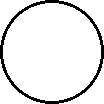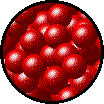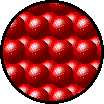Gases, liquids and solids are all made up of atoms, molecules, and/or ions, but the behaviors of these particles differ in the three phases. The following figure illustrates the microscopic differences.
 |  |  |
| Microscopic view of a gas. | Microscopic view of a liquid. | Microscopic view of a solid. |
Note that:
- Particles in a:
- gas are well separated with no regular arrangement.
- liquid are close together with no regular arrangement.
- solid are tightly packed, usually in a regular pattern.
- Particles in a:
- gas vibrate and move freely at high speeds.
- liquid vibrate, move about, and slide past each other.
- solid vibrate (jiggle) but generally do not move from place to place.
Liquids and solids are often referred to as condensed phases because the particles are very close together.
The following table summarizes properties of gases, liquids, and solids and identifies the microscopic behavior responsible for each property.
| Some Characteristics of Gases, Liquids and Solids and the Microscopic Explanation for the Behavior | ||
|---|---|---|
| gas | liquid | solid |
| assumes the shape and volume of its container particles can move past one another | assumes the shape of the part of the container which it occupies particles can move/slide past one another | retains a fixed volume and shape rigid - particles locked into place |
| compressible lots of free space between particles | not easily compressible little free space between particles | not easily compressible little free space between particles |
| flows easily particles can move past one another | flows easily particles can move/slide past one another | does not flow easily rigid - particles cannot move/slide past one another |
- 47
The Three States of Matter Are: x x x <----- Liquid x x x x x x <--- Gas x
solid, liquid and gases.
The difference between these three states of matter are that the particles in a solid are tightly compressed and compact,which make it hard for the particles to move around.
The particles in a liquid are more spread out and allow movement, such as collision, to happen. A liquid takes the shape of any given container, but try to expand as much as possible.
The particles in a gas are far more spread out than in a liquid, which allows alot of fast movement and space for the particles to move. Spinning can also occur with the particles in gases. Gases also push outward and try to expand rapidly, such as steam from a boiling kettle.
xxxxxx
xxxxxx <----Solid
xxxxxx
- 2
The 3 states are solid, fluid, and liquid. The given equation calculates out to give a model of the relations of p v and T (pressure, volume and Tempature) that define each state. In most cases as tempature goes down, you get closer to solid, or as volume does down, etc. Some types of matter done have much of a fluid state or a solid state. others dont have as much a solid state as you would think, such as room temprature butter is acutally a fluid. pvn=RT. The 3 states are solid, fluid, and liquid. The given equation calculates out to give a model of the relations of p v and T (pressure, volume and Tempature) that define each state. In most cases as tempature goes down, you get closer to solid, or as volume does down, etc. Some types of matter done have much of a fluid state or a solid state. others dont have as much a solid state as you would think, such as room temprature butter is acutally a fluid. The states of matter are defined by their molecular activity--meaning their microscopic structure, basically. Solids have a very repetitive structure, often called a lttice structure, which forms a sort of box-like shape in rows of molecules. The molecules vibrate very gently, undetectable to humans. So pretty much for a solid to move they have to vibrate because it is so closely packed together. Liquids are much less structured, tending to "flow" in loose chains of molecules or even separate, depending on the liquid. The molecules are more chaotic and move more quickly than those in a solid. Liquids are alot less free than solids because they are not as tightly packed together. Gases are random and unpredictable. The molecules move in no reasonable order and move very quickly and erratically. Usually, the molecules are separate bonds, not bonded together as in the two other states. This is also why we cannot usually see a gas (such as oxygen). Heat changes affect these states of matter, depending on the solution and it's elements. Generally, as heat decreases, molecular speeds decrease and the solution becomes solid; likewise, as heat increase the molecules become chaotic and form a gas. Water for instance, goes from ice, to liquid water, to water vapor, depending on the heat involved. Think of cooking and the steam (vapor) or the coldness of ice.
- 0
*negligible compressibility
*definite shape,size,boundary
*no particle motion
liquid phase:*no fixed shape and boundary
*have a fixed volume
*low compressibility
*lesser particle motion
gaseous state:*no fixed shape,volume,boundary
*highly compressible
*gas exerts pressure on the walls of the container
*high particle motion
- -1
The difference between solid, liquid and gas can be drawn clearly on the following grounds:
- 1 A substance having structural rigidity and has a firm shape which cannot be changed easily is called solid. A water-like fluid, that flows freely, having a definite volume but no permanent shape, is called liquid. Gas refers to a state of matter, do not have any shape but conform to the shape of the container, completely, in which it is put in.
- 2 While solids have certain shape and volume, liquids only have definite volume but not shape, gases neither have shape nor volume.
- 3 The level of energy is highest in gases, medium in liquid and lowest in solids.
- 4 The compression of solids is difficult, liquids are nearly incompressible, but gases can be easily compressed.
- 5 Molecular arrangement of solids is regular and close, but liquids have irregular and sparse molecular arrangement and gases, too have random and more sparse arrangement of molecules.
- 6 The molecular arrangement in solids is well organised. However, the layers of molecules slip and slide over one another, in the case of liquids. In contrast, the particles in gases are not at all organised, due to which the particles move randomly.
- 7 When it comes to fluidity, solids cannot flow, however, liquids can flow and that also from the higher level to lower level. As against this gases flows in all directions.
- 8 The spaces between the molecules and the kinetic energy are minimum in solids, medium in liquid and maximum in gases. So, the motion of molecules is negligible in solids, whereas in liquids, the erratic, random motion of molecules can be seen. Unlike gases, which have the free, constant and random motion of molecules.
- 9 In solids, the particles are held tightly by strong intermolecular attraction, although in liquids the attraction between particles is intermediate. As against this, the particles are loosely held, because the intermolecular attraction is weak.
- 10 The speed of sound is highest in solids, while the speed is a bit slower in liquids and minimum in gas.
- -1
- strongest -weaker than solids -negligible
-fixed shape
and volume -no fixed shape -neither fixed shape no
but fixed volume fixed volume
-negligible -higher than solids -highest
-very low -higher than solids -highest
- highest -lower than solids -least
-very small -higher than solids -highest
- ice -water -water vapour
- -1
solid, liquid and gases.?
The difference between these three states of matter are that the particles in a solid are tightly compressed and compact,which make it hard for the particles to move around.?
The particles in a liquid are more spread out and allow movement, such as collision, to happen. A liquid takes the shape of any given container, but try to expand as much as possible.?
The particles in a gas are far more spread out than in a liquid, which allows alot of fast movement and space for the particles to move. Spinning can also occur with the particles in gases. Gases also push outward and try to expand rapidly, such as steam from a boiling kettle.?
xxxxxx?
xxxxxx xxxxxx?
?
x x x
x x x x?
?
?
x x
x
Hope this will help you!!
- -1
- -1
A. It has definate shape.
B. It has definate volume.
C. It has high density.
D. It has high melting and boiling point.
E. It can not flow.
F. It can not compress.
G. It can not fill the vessel completly in which it is kept.
H. It can not break into small pieces.
Liquid
A. It has indefinate shape.
B. It has definate volume.
C. It has moderate density.
D. It has moderate melting and boiling point.
E. It can flow.
F. It can be compressed.
G. It can not fill the vessel compeletly in which is it kept.
H. It can break into small peices.
Gass
Avolume.
C. It has high density.
D. It has high melting and boiling point.
E. It can not flow.
F. It can not compress.
G. It can not fill the vessel completly in which it is kept.
H. It can not break into small pieces.
Liquid
A. It has indefinate shape.
B. It has indefinate volume.
C. It has low density.
D. It has low melting and boiling point.
E. It can flow.
F. It can be compressed.
G. It can fill the vessel compeletly in which is it kept.
H. It can break into powered.
- -1
2)* A solid has a fixed volume, a liquid has a fixed volume but a gas does not have a fixed volume it acquires volume if vessel in which placed.
3)* A solid has negligible compressibility, a liquid has more compressibility than solid and a gas has highest capability of compressibilty.
4)*A solid is very rigid , a liquid is less rigid compared to solid and a gas has negligible rigidity.
- -1
5)* A solid has minimum kinetic energy and a liquid has more than a solid and a gas has maximum K.E.
6)*A solid has strong force of attraction between its particles and a liquid has quite strong force of attraction but less to solids and a gas has negligible force of attraction
7)* In a solid the particles are closely fitted and in a liquid the particles are not as close as are in solid and in gases the particles are much farther apart.
- -1
8)* A solid cannot flow and a liquid can be generally flow whereas a gas is flow easily.
9)* A solid has negligible distance between its particles and in a liquid the distance is more than in solid whereas in a gas the particles distance is very large
10)* diffusion is slowest in solids a little more in liquids and fastest in gases
So cheerrz upp both 3 sets of differences ..
- -1
- -1
1. Have high melting point
2. Rigid
3.high intermolecular force
4.low intermolecular space
5.have fixed shape and volume
6.high density
7.cannot be compressed easily
8.tightly held...
9.doesnot have fluidity
10.have less energy
Liquid
1.moderate
Melting point......... (same that of solid) but can flow
Has definite volume but no definite shape...
Gases
Have high melting point.......
..............can be compressed......... Can flow...
- -1
SolidsLiquidsGasesHighly Strong intermolecular forces between the molecules, leads to a definite volume in Solids.The intermolecular forces are stronger than gases but weaker than solids.The intermolecular forces are practically non-existent. Thus, there is no definite volume.Solids have a definite shape to them.Liquids do not have a definite shape.Gases do not have a definite shape.The intermolecular space between solids is absent.The intermolecular space is moderate but present.The intermolecular space is free-flowing and plenty.The force of attraction between the molecules is incredibly high.The force of attraction between molecules is pretty moderate.There is no intermolecular force of attraction between the molecules.They are incompressible
- 0
Difference between Solid Liquid and Gases |
||
|---|---|---|
| Solids | Liquids | Gases |
| Highly Strong intermolecular forces between the molecules, leads to a definite volume in Solids. | The intermolecular forces are stronger than gases but weaker than solids. | The intermolecular forces are practically non-existent. Thus, there is no definite volume. |
| Solids have a definite shape to them. | Liquids do not have a definite shape. | Gases do not have a definite shape. |
| The intermolecular space between solids is absent. | The intermolecular space is moderate but present. | The intermolecular space is free-flowing and plenty. |
| The force of attraction between the molecules is incredibly high. | The force of attraction between molecules is pretty moderate. | There is no intermolecular force of attraction between the molecules. |
| They are incompressible. | Liquids cannot be compressed. | Gases can be compressed quite easily. |
- 0
2. These particles have very less space between them.
3. Solid cannot be compressed easily.
4. These particle have least kinetic energy.
5. These particles have least energy.
6. Solid cannot flow.
7. A solid cannot fill the container completely.
8. There boiling point and melting point is above room temperature.
9. Solids show only slight expansion on heating.
10. Solids have fixed shape and volume.
Liquid:- 1. The particles of liquid are not tightly packed.
2. These particles have intermediate intermolecular space between them.
3. Liquid can be compressed.
4. These particles have intermediate kinetic energy.
5. These particles have intermediate energy.
6. Liquid can flow easily.
7. Liquids cannot fill the contain completely.
8. Liquids have melting point below and boiling point above the room temperature.
9. Liquids shows intermediate expansion on heating.
10. Liquid do not have fixed shape but have fixed volume.
Gas:- 1. The particles of gas are loosely packed.
2. These particles have high intermolecular space.
3. Gas can be compressed very easily.
4. Gas have very high kinetic energy.
5. These particles have very high energy.
6. Gas can flow.
7. Gas can fill the container completely.
8. The boiling point and melting point is below the room temperature.
9. Gas show very high expansion on heating.
10. Gas does not have fixed shape and volume.
- 1
The Three States of Matter Are:
solid, liquid and gases.
The difference between these three states of matter are that the particles in a solid are tightly compressed and compact,which make it hard for the particles to move around.
The particles in a liquid are more spread out and allow movement, such as collision, to happen. A liquid takes the shape of any given container, but try to expand as much as possible.
The particles in a gas are far more spread out than in a liquid, which allows alot of fast movement and space for the particles to move. Spinning can also occur with the particles in gases. Gases also push outward and try to expand rapidly, such as steam from a boiling kettle.
xxxxxx
xxxxxx <----Solid
xxxxxx
x x x <----- Liquid
x x x x
x x <--- Gas
x
- 5













